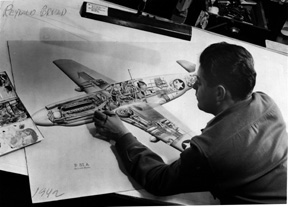| Reynold Brown possibly began working for North American Aviation in Inglewood, California about May, 1942. He worked in the art section of the handbook division of the engineering department. Most of this work initially involved the translation of blueprints into three dimensional drawings and paintings of the various aircraft and associated equipment. Drawing on his earlier skills of story telling developed while working on Tailspin Tommy, Brown interpreted the various stories the pilots told of their experiences in the war. One of these paintings showing the B-25 raid on Tokyo early in the war was presented to the raid commander, General Jimmy Doolittle, in 1946. Brown's paintings and drawings were also used in the North American in-house publication, Skyline, as well as a number of aviation magazines, such as Industrial Aviation and Flying. | |
 |
Brown was the first to develop what were then called phantom drawings or paintings (also called "cutaways"). These extremely complex paintings involved presenting the entire aircraft as if covered in a clear skin. Initially done for North American the magazines also wanted to publish them. Surprisingly detailed paintings of the aircraft were published by the magazines. The phantoms done for publication were worked on at home from blueprints supplied by the aviation magazines. Brown's co-worker, Mary Louise Tejeda, assisted him by doing all the work on the wings and the tail area, Brown concentrated on the fuselage. |
| Although called before the
draft board a number of times, Brown was never drafted.
Each time plant supervisors went before the board and
argued that Brown's abilities were essential to the
production of the aircraft. When the war ended Brown proposed to Tejeda. She suggested that he first go to New York to see if he could get started in the illustration field. With letters of introduction provided by his high school art teacher, Lester Bonar, Brown left for New York. There he met a number of illustrators and made the contacts necessary to start an illustration career. Brown returned to California, where he married Tejeda on October 26, 1946. A few days later he caught pneumonia and was soon near death. The family doctor, (Wuester) suggested he be given a drug which was just being introduced, penicillin. After his recovery, he went back to New York, this time with his new bride, and began his career. |
|
"Phantom" paintings by Reynold Brown.
Click on aircraft names for enlargement.
| P-51 Mustang | P-38 Lightning | PV-1 Ventura | B-24J Liberator | |||
| Constellation | F4U-1D Corsair | P-47D Thunderbolt | ||||
To Home Page: To Early Years Introduction